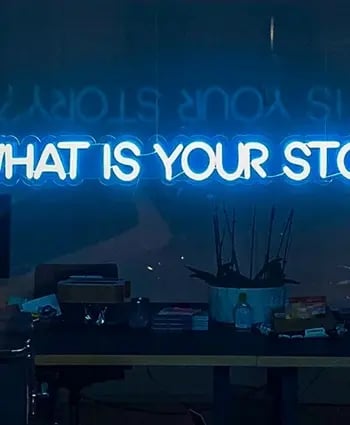How to Create Training Videos that Don't Suck [Free Guide]
Create impactful training videos that educate, engage, and drive change. Download our guide for enjoyable learning methods.
Engaging and informative training videos are a powerful way to train and educate your staff. One of the reasons that they are so effective is that the human brain can process visual information faster and retain it for longer than it can with the written word.
Visuals cause a faster and stronger reaction than words. They help users engage with the content, and such emotional reactions influence information retention.
 How to Create Training Videos that Don't Suck
How to Create Training Videos that Don't Suck
Connect your team, communicate messages that stick, and drive real organisational change.
Read the guide packed full of all we've learned over six years of making training videos for clients like the NHS, Unilever and Experian.
 There's almost nothing worse than a truly awful training video.
There's almost nothing worse than a truly awful training video.
They're dull. Ineffective. Maybe even a bit insulting.
But it doesn't have to be this way, video as a medium is actually ideally suited to creating excellent training content.
Why? Because it's a highly engaging, attention-grabbing, emotion-generating form of content.
You can create effective training videos that teach skills, generate discussion and drive change while being enjoyable for your colleagues.
It's not easy... otherwise everyone would be doing it.
But it's worth it when you think about the alternative, wasted time and investment, a bruised reputation, and videos so awful that they simply confuse and/or annoy your team.
Successful training videos require plenty of forethought and planning. We've put together How to Create Training Videos that Don't Suck: A Guide, a summing-up of everything we've learned over 6 years of making them, to help lead you through this complex process. Read on for an overview of its contents, or click the button below to download it now.
6 Simple Steps to Creating Engaging, Emotional, Effective Training Videos
1. Know Why You Want Training Video
First of all comes the most important and fundamental question to answer. Why do you need your training videos?
The general aim of any piece of training content is to teach someone something new so that it sticks, whether that's a skill, a concept or an attitude. But we need to get more specific than that. What outcome are you looking to bring about? What behaviour do you want to alter? What organisational change do you want to see?
Make sure you're clear on your goals, because your video content will be structured around them. For example, if you want to kickstart discussion and prepare colleagues for real-life situations then you should consider creating scenario-based training videos.
Free resource: You can use our Video Objectives Template to help you set video goals.
2. Work Out What You Need to Say
Now you know why you need a training video. But do you know what it should communicate?
The message of your training content is a delicate balance between what your audience need to hear in order to change their behaviour or attitudes, and what they actually care about.
Every video should have a specific emotional heart that allows it to resonate with your colleagues. Why should they pay attention? What personal impact might this 'dry' subject have on them? Health and safety might sound boring on the surface, but everybody wants to return home safe to their loved ones at the end of the day.
From here you need to work out the core message that your training video will communicate, or the one thing viewers should take away after watching. Just one is enough, otherwise you'll overwhelm your audience, although it can be supported by sub-messages.
Doing this well requires a thorough understanding of the psychology of learning. You may need assistance with creating, structuring and pitching an effective core message.
3. Craft Your Creative Approach
The next step is working out how you'll communicate your message in an exciting and engaging way. How will you inject some creativity into your training video? In short, how will you make it not suck?
What you need is a creative concept that brings your core message to life and resonates with the values, cares and concerns of your audience. Emotion is the most powerful tool at your disposal to encourage viewers to connect, learn, and grow, so don't be afraid to use it.
There are numerous emotional techniques that might work in your videos, such as telling a story, being funny, or using visual metaphors. The right approach for each situation is going to depend on the message you need to communicate, what you're looking to achieve, and the personalities of your viewers.
Looking for inspiration? Check out our roundup of 6 impressive training video examples.
4. Decide Who'll Make Your Videos
When it comes to the practical side of training videos, the biggest question is deciding who will create them. You basically have two options: produce them in-house or work with an external video agency. Your decision will depend on your capabilities and resources in the face of the task at hand.
Many organisations assume that, because they're experts in their industry, they know best how to create training materials. And that might be true to a certain extent when it comes to some types of content. But successful training videos require a skilful understanding of both filmmaking and the psychology of learning. Even a fairly experienced internal team may struggle to create videos to a certain standard or within a short timeframe.
Always keep in mind: how ambitious is the content you want to produce? How much do you want to invest in it?
Working with an external agency isn't for everyone, but it does allow you to reach a higher quality of end product, and a smoother experience along the way, by paying for expertise, efficiency and professionalism. You'll also be supported by an experienced video partner (like us!) who'll help with every stage of the process, from picking the creative approach to crafting an effective story.
5. Get Your Training Videos Watched
Actually getting your training videos watched by your colleagues can be the hardest part of this whole process. It's also why you should be thinking about distribution early in the planning stages.
How and where you share your videos will vary depending on the topics dealt with, who needs to be trained, and how urgent that training is. There are several options available to you, including:
- emailing your video content to relevant teammates,
- placing it in a dedicated area of your intranet, or
- showing it at an internal event.
Generally you'll get the best results when you give colleagues as many options as possible to watch the video when and where they want.
However you distribute your training videos, make sure you increase the likelihood that they're watched by being upfront about what they cover, using enticing thumbnails and placing them somewhere easily discoverable.
6. Measure and Understand the Impact
Finally, you need to keep track of the performance of your training videos to understand if they've had the impact you hoped for. Have you achieved your training goals?
We recommend investing in a specific training platform to host your videos and allow you access to key video metrics, data like how much of a video viewers watched, and how many of them took a desired action afterwards, can be invaluable.
But to really measure the impact of your training videos you'll need to go beyond basic engagement metrics. What do collagues remember from your videos? What behavioural changes have you seen as a result? Has there been any measurable impact on business, such as higher productivity?
The more you track the effectiveness of your training videos, the better you'll be able to make them in the future. These measures aren't easy to find, but they're a committment to continual improvement that will strengthen all of your training content, not just video.
Round-Up: Change Attitudes, Behaviour and Culture with Training Videos
These basic guidelines give you the understanding you need to start creating truly effective training videos.
But if you want to craft the highest-quality pieces of learning content, there's a lot more to take into account. There are ways to supercharge the impact your videos have, incredible examples to inspire you, and common stumbling blocks to avoid.
Our comprehensive guide to training videos, aptly entitled How to Create Training Videos that Don't Suck: A Guide, covers all of these topics and more. Plus, it explains the handiest tips and tricks we've picked up over the years. Download it now to learn the 7 key elements of training videos that engage your colleagues, transform behaviours and drive real change.
Written by Lydia Cockerham Copywriter for Venture Videos — a full-service video production agency that specialises in producing creative videos & campaigns that get real results.




